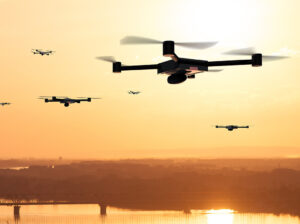The Army is seeking industry’s information on new turreted gun-based counter-drone capabilities and available small UAS solutions capable of rapid reconfiguration of mission payloads, according to a pair of notices published on Friday.
Army Aviation and Missile Command (AMCOM) wrote in one of the notices that it’s anticipating an upcoming requirement for a new gun-based C-UAS capability, with the new market survey intended to understand industry’s potential for “designing, documenting, manufacturing, and integrating” such a solution.

“The purpose of this announcement is to gain knowledge of interest, capabilities and qualification of businesses to compete and perform a hybrid-type contract with fixed price and cost reimbursable requirements,” AMCOM wrote in the notice.
AMCOM said it would likely be interested in a gun-based counter-drone offering that’s mobile, vehicle-mounted, utilizes an active radar, has capability for electro-optical/infrared detection and has an “ability to engage and destroy UAS using a cannon with rapid fire and automatic aiming controlled by an operator.”
Interested vendors are asked to provide information on their potential solutions’ caliber and type of ammunition for the gun-based solution, proposed turret and radar model specifications, any performance data against Group 3 UAS, average number of rounds required per engagement and relevant vehicle platform the system could be integrated onto for demonstration.
Separately, the Army released a notice on Friday to gather information on industry’s “available and viable” solutions for company-level small UAS (sUAS) that could be used for follow-on demonstrations and potentially fulfill a future directed requirement or “urgent capability acquisition.”
“[The Army’s] Program Executive Office Aviation, Project Manager, Uncrewed Aircraft Systems, seeks information on a commercial off the shelf, production ready, attritable, cost-effective and affordable, small UAS which will be employed at the maneuver small unit level. The system’s baseline mission characteristics include a rapidly reconfigurable, modular payload capability to execute mission changes across the primary reconnaissance, surveillance, and target acquisition mission with additive capabilities to execute target identification, communications relay, and kinetic missions,” the Army wrote in the sources sought notice.
A list of “desired capabilities” for the potential sUAS requirement include vertical takeoff and landing-capable air vehicles that weight no more than 55 pounds, must be portable by two soldiers, have a minimum Line of Sight datalink range of 10 kilometers and ability to operate for eight hours over a 24-hour period.
The Army notes it’s also interested in modular mission payloads for sUAS, to include EO/IR sensors, communications relay and tactical network extension, anti-personnel and anti-materiel lethality solutions and and electronic warfare capabilities.
“The users operationally dynamic mission changes require a system with a common payload interface to rapidly remove and install air vehicle mission payloads,” the Army wrote in the notice.
The Army said it may invite selected vendors to demonstrate capabilities, and asked that interested companies respond with their currently available sUAS offerings’ system cost, description of payload sensor performance, air vehicle performance characteristics and ground control station details.
Army Secretary Christine Wormuth told reporters last week that Congress’ delay in passing final FY ‘24 appropriations and the national security supplemental is hindering efforts to get after new UAS and counter-UAS programs (Defense Daily, Feb. 27).
“Without the ability to do new starts and reprogrammings, we can’t invest in development of UAS and counter UAS. We can’t train with those systems. We can’t produce those systems as rapidly as we want to,” Wormuth said.